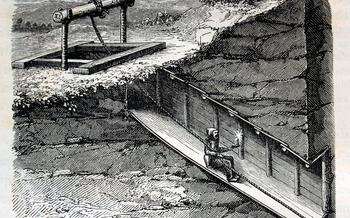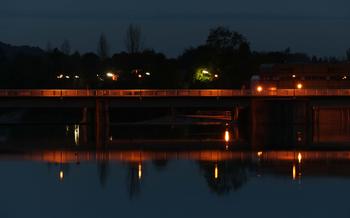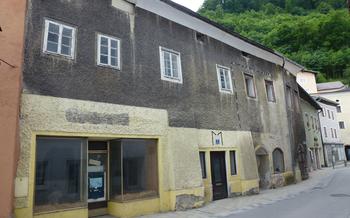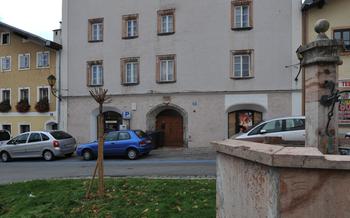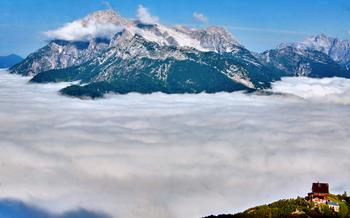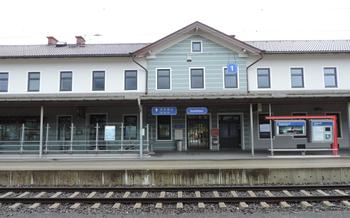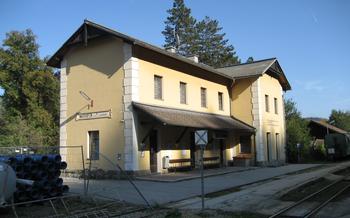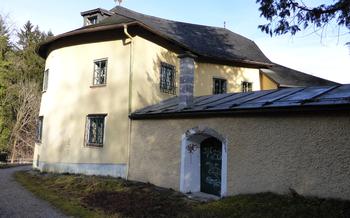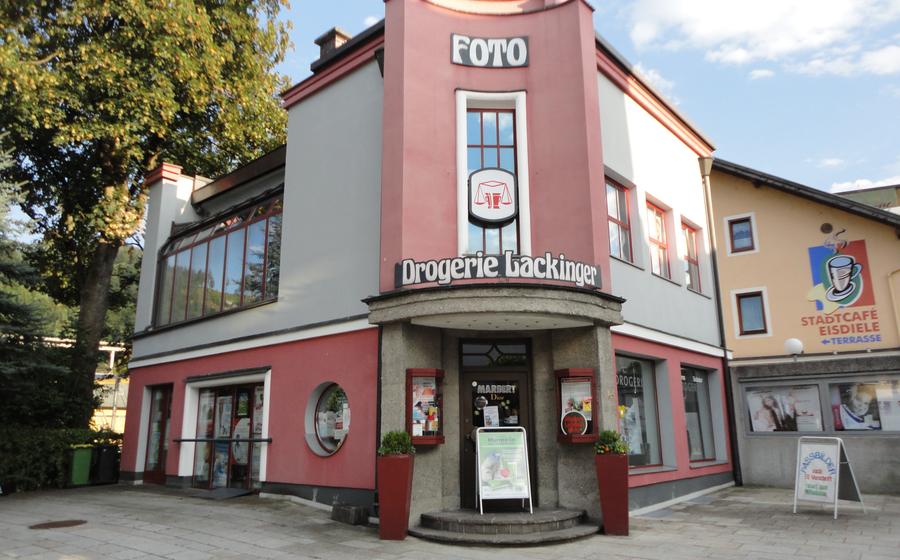
Salzwelten Hallein (salt mines)
- Salzwelten Hallein: A Journey into the Heart of Salt
- A Trip Back in Time: The History of Salzwelten Hallein
- Exploring the Salt Caves: A Natural Wonder
- A Multisensory Experience: Visiting the Salzwelten Hallein
- Planning Your Visit: Practical Information
- Insider Tips for the Best Experience
- The Celtic Legacy: The Early Days of Salt Mining
- The Rise of Hallein: A Salt Mining Powerhouse
- Salt and the Austrian Economy: A Vital Resource
- The Challenges of Balancing Economic Development with Environmental Protection
- The Challenges of Modern Salt Mining
- The Geological Wonders of the Salt Caves
- The Unique Flora and Fauna of the Salt Caves
- The Sensory Experience of the Salt Mines
Salzwelten Hallein: A Journey into the Heart of Salt
Journey into the heart of salt at Salzwelten Hallein, Austria, where the ancient Celtic miners first discovered the "white gold" that would shape the destiny of this region. Immerse yourself in the fascinating history of salt mining, dating back to the Middle Ages, and witness the ingenuity of the miners who carved a labyrinthine network of tunnels deep beneath the surface. Explore the natural wonders of the salt caves, with their glistening salt crystals, subterranean lakes, and unique geological formations. Embark on an unforgettable adventure into the heart of salt, where the past and present intertwine, and the spirit of the miners lives on.
A Trip Back in Time: The History of Salzwelten Hallein
The Salzwelten Hallein has a rich and fascinating history that dates back to the Celtic period. The Celts were the first to discover the salt deposits in the area and began mining them around 500 BC. Salt was a valuable commodity in the ancient world and was used for food preservation, as a seasoning, and for religious ceremonies. The Celts traded salt with other tribes throughout Europe, and Hallein soon became a major center of salt production.
In the Middle Ages, the salt mines of Hallein were owned by the Archbishops of Salzburg. The archbishops used the salt mines to generate revenue and to support their military campaigns. The salt mines also played an important role in the development of the city of Hallein. The city grew up around the salt mines and became a major center of trade and commerce.
In the 19th century, the salt mines were industrialized and new technologies were introduced to increase production. The salt mines also became a popular tourist destination, and visitors from all over the world came to see the underground workings and to learn about the history of salt mining.
Today, the Salzwelten Hallein is a UNESCO World Heritage Site and is one of the most popular tourist attractions in Austria. The salt mines are open to the public and offer a variety of tours and activities. Visitors can learn about the history of salt mining, see the underground workings, and even taste the salt.
Exploring the Salt Caves: A Natural Wonder
The salt caves at Salzwelten Hallein are a captivating natural wonder that showcase the extraordinary beauty and diversity of the subterranean world. Formed over millions of years by the evaporation of ancient seawater, these caves are a testament to the Earth's geological processes.
The walls of the caves are adorned with glistening salt crystals, creating a mesmerizing spectacle of light and color. The unique geological formations, such as stalactites, stalagmites, and salt waterfalls, add to the otherworldly ambiance of the caves.
The salt caves are also home to a unique ecosystem, adapted to the harsh conditions of the salt environment. Salt-tolerant plants, such as mosses and ferns, cling to the cave walls, while salt-loving animals, such as brine shrimp and cave beetles, thrive in the salty waters.
Visitors to the salt caves can marvel at the breathtaking views from the observation platforms, which offer panoramic vistas of the surrounding countryside. The sensory experience of being surrounded by salt is truly unique, creating a calming and rejuvenating atmosphere.
A Multisensory Experience: Visiting the Salzwelten Hallein
A visit to the Salzwelten Hallein is not just an educational experience; it is a multisensory journey that engages all of your senses. The sights, sounds, and smells of the salt mines create a truly immersive experience that will stay with you long after your visit.
Sight
The salt mines are a feast for the eyes. The white walls of the salt caves sparkle and gleam, reflecting the light from the miners' lamps. The stalactites and stalagmites that line the caves are a testament to the power of nature, and the underground lake is a sight to behold.
Sound
The salt mines are a symphony of sound. The dripping of water, the clanging of tools, and the echo of voices create a unique acoustic environment. The sound of the salt crystals crunching under your feet is a reminder that you are in a place like no other.
Smell
The salt mines have a distinctive smell that is both fresh and pungent. The smell of salt is invigorating and cleansing, and it is said to have therapeutic benefits.
Touch
The salt mines are a place where you can touch and taste the salt. The walls of the caves are covered in a layer of salt crystals that you can run your fingers over. You can also taste the salt on your lips as you breathe in the air.
Taste
The salt mines offer a unique opportunity to taste the salt. You can lick the salt crystals off the walls of the caves, or you can try your hand at making your own salt. There are also a number of salt-themed products available in the gift shop, such as salt chocolate and salt beer.
Planning Your Visit: Practical Information
Visiting the Salzwelten Hallein is a unique and memorable experience, but it's essential to plan to make the most of your trip. Here are some practical tips to help you plan your visit:
Getting to the Salzwelten Hallein: The salt mines are located in Hallein, a town about 15 kilometers south of Salzburg. You can reach Hallein by car, taking the A10 highway and exiting at Hallein. Alternatively, you can take a train from Salzburg to Hallein, which takes about 20 minutes.
Admission fees and discounts: The entrance fee for the Salzwelten Hallein varies depending on the time of year and the type of ticket you purchase. Adult tickets typically cost around €20, while children's tickets are usually half-price. There are also discounts for students, seniors, and families.
Guided tour options and availability: Guided tours of the salt mines are available in several languages, including English, German, French, and Italian. Tours typically last about 5 hours and cover the history, geology, and mining process of the salt mines. It's recommended to book your tour in advance, especially during peak season.
Recommended duration of the visit: Plan to spend at least 5 hours exploring the salt mines, including the guided tour. If you want to take your time and enjoy the interactive exhibits, you may want to allow for up to 2 hours.
Insider Tips for the Best Experience
To make the most of your visit to the Salzwelten Hallein, here are a few insider tips:
- Plan your visit for the summer months: The salt mines are open year-round, but the best time to visit is during the summer months when the weather is warm and sunny. This will allow you to enjoy the outdoor areas of the salt mines, such as the salt lake and the viewing platform.
- Wear comfortable shoes and clothing: You will be doing a lot of walking and climbing during your visit, so it is important to wear comfortable shoes and clothing. Avoid wearing heels or sandals, as the floors of the salt mines can be slippery.
- Bring a camera: The salt mines are a photographer's paradise, with stunning views and unique photo opportunities around every corner. Be sure to bring your camera to capture all the memories of your visit.
- Take advantage of the guided tours: The guided tours of the salt mines are a great way to learn more about the history and geology of the mines. Tours are available in several languages, so you are sure to find one that fits your needs.
- Combine your visit with other attractions in the area: The Salzwelten Hallein is located in the heart of the Austrian Alps, so there are plenty of other attractions to visit in the area. Some popular options include the Dachstein Glacier, the Krimml Waterfalls, and the Hohenwerfen Castle.
The Celtic Legacy: The Early Days of Salt Mining
The history of salt mining in Hallein dates back to the Celtic era. The Celts were the first to discover the rich salt deposits in the region and began extracting salt as early as the 5th century BC. They used simple tools and techniques to dig into the salt deposits and extract the salt crystals. The salt was then transported to other parts of the Celtic world, where it was used for preserving food, flavoring dishes, and as a form of currency.
The Celts held salt in high regard and believed it to have magical properties. They often used salt to bless their homes and livestock and to protect themselves from evil spirits. The Celtic legacy of salt mining can still be seen in Hallein today, where many of the salt mines are named after Celtic deities and heroes. The most famous of these is the Dürrnberg salt mine, which is named after the Celtic god of the underworld, Dürrn.
The Rise of Hallein: A Salt Mining Powerhouse
Hallein's rise as a salt mining powerhouse can be attributed to several key factors. Its strategic location at the foot of the Dürrnberg mountain, where rich salt deposits were discovered, provided the foundation for its success. The abundance of salt, coupled with the favorable geological conditions, made Hallein an ideal site for salt extraction.
The development of innovative salt mining techniques further contributed to Hallein's prominence. The introduction of new technologies, such as the water-powered pumps and the use of gunpowder for blasting, increased the efficiency and productivity of salt mining operations.
Hallein's salt industry also benefited from the political and economic conditions of the time. The region's rulers, the Archbishops of Salzburg, recognized the importance of salt as a valuable commodity and supported its development. The establishment of trade routes and the growing demand for salt in the surrounding regions further fueled Hallein's economic growth.
As a result of these factors, Hallein emerged as a major salt producer, supplying salt to a vast region and becoming a significant economic and political force in the area.
Salt and the Austrian Economy: A Vital Resource
Salt has played a crucial role in the development of the Austrian economy. As a valuable commodity traded throughout Europe, it brought wealth and prosperity to the regions where it was mined. In Hallein, the salt industry was a major source of revenue for the local government and played a vital role in the development of the town's infrastructure. The salt trade also contributed to the growth of other industries, such as transportation and manufacturing.
Throughout history, salt has been a strategic resource that has influenced political and economic power dynamics. In Austria, the control of salt mines was often a source of conflict between different ruling families and states. The Habsburg monarchy, which ruled Austria for centuries, recognized the importance of salt and made it a state monopoly. This allowed the Habsburgs to generate significant revenue and exert control over the economy.
Despite the decline of the salt industry in recent decades, salt mining remains an important part of the Austrian economy. Today, salt is primarily used for industrial purposes, such as in the production of chemicals, plastics, and food. The salt mines in Hallein continue to operate, producing high-quality salt that is used both domestically and internationally.
The Challenges of Balancing Economic Development with Environmental Protection
Balancing economic development with environmental protection is a significant challenge facing the salt mining industry in Austria. Salt mining can have various environmental impacts, including air and water pollution, land degradation, and habitat loss. To mitigate these impacts, salt mining companies are implementing sustainable practices and investing in new technologies.
One of the most significant environmental challenges associated with salt mining is the disposal of wastewater. Salt mining operations produce large amounts of wastewater, which can contain high concentrations of salt and other contaminants. If not properly treated, this wastewater can pollute rivers and streams, harming aquatic life and ecosystems.
Another environmental concern is the emission of greenhouse gases from salt mining operations. The use of heavy machinery and the transportation of salt require significant amounts of energy, which can contribute to climate change. Salt mining companies are working to reduce their carbon footprint by using more energy-efficient technologies and investing in renewable energy sources.
By implementing sustainable practices and investing in new technologies, the salt mining industry in Austria is working to minimize its environmental impact while continuing to produce a valuable resource for the economy.
The Challenges of Modern Salt Mining
Modern salt mining faces a number of challenges, including the environmental impact of the mining process, the need for sustainable mining practices, the challenges of maintaining profitability in a competitive market, and the role of technology in modern salt mining.
The environmental impact of salt mining is a major concern, as the mining process can release harmful pollutants into the air and water. Salt mining can also lead to the destruction of natural habitats and the displacement of wildlife. In order to mitigate these impacts, salt mining companies are increasingly adopting sustainable mining practices, such as using less water and energy, reducing emissions, and recycling waste.
The global salt market is highly competitive, and salt mining companies face the challenge of maintaining profitability in a market where prices are often volatile. In order to remain competitive, salt mining companies are investing in new technologies to improve efficiency and reduce costs.
Technology plays a vital role in modern salt mining, and salt mining companies are increasingly using new technologies to improve the efficiency and safety of their operations. For example, some salt mining companies are using drones to map and survey their mines, while others are using laser technology to cut and shape salt blocks.
The Geological Wonders of the Salt Caves
The salt caves of Hallein are a geological wonderland, home to unique formations and structures that have been shaped by millions of years of salt crystallization. The caves are composed of various types of salt deposits, including halite, anhydrite, and gypsum, which have been deposited in layers over time. The walls of the caves are adorned with intricate patterns and textures, created by the different colors and crystal shapes of the salt.
One of the most striking features of the salt caves is the presence of salt crystals, which can be found in a variety of sizes and shapes. These crystals are formed when salt water evaporates, leaving behind pure salt crystals. The salt crystals in the Hallein salt caves are particularly impressive, some of which are several meters in length.
The salt caves are also home to a variety of other geological formations, including stalactites and stalagmites. These formations are created by the slow dripping of water through the salt deposits. As the water evaporates, the dissolved salt is deposited, forming these beautiful and delicate structures.
The salt caves of Hallein are a fascinating and awe-inspiring sight, offering a glimpse into the geological processes that have shaped our planet. They are a must-see for anyone interested in geology, natural history, or simply the wonders of the natural world.
The Unique Flora and Fauna of the Salt Caves
The salt caves of Hallein are home to a unique and diverse ecosystem, with a variety of plants and animals that have adapted to survive in this harsh and salty environment. These organisms have evolved remarkable adaptations that allow them to thrive in conditions that would be inhospitable to most other life forms.
Among the most fascinating creatures found in the salt caves are the brine shrimp, tiny crustaceans that can survive in water with a salt content of up to 35%. These shrimp have developed specialized mechanisms to regulate their internal salt balance, allowing them to live in an environment that would be deadly to most other aquatic organisms.
Other notable inhabitants of the salt caves include salt-tolerant plants, such as the saltwort and the sea lavender. These plants have evolved thick, succulent leaves that help them retain water and reduce water loss through transpiration. They also have a high tolerance for salt, which allows them to thrive in the salty soil of the caves.
The salt caves also provide a habitat for a variety of insects, including flies, beetles, and spiders. These insects have adapted to the high salt content of the caves by developing specialized feeding habits and behaviors. For example, some flies have developed long proboscises that allow them to feed on the salt crystals that form on the walls of the caves.
The unique flora and fauna of the salt caves of Hallein are a testament to the power of evolution and adaptation. These organisms have evolved remarkable strategies to survive in a challenging and unusual environment, and they play an important role in maintaining the ecological balance of the caves.
The Sensory Experience of the Salt Mines
Visiting the Salzwelten Hallein is a multisensory experience that engages all of your senses. The sight of the sparkling salt crystals, the sound of dripping water and the rumble of machinery, the smell of the salt in the air, the taste of the salt on your tongue, and the feeling of the salt on your skin all combine to create a truly unique and memorable experience.
The salt mines are a feast for the eyes. The walls of the tunnels and chambers are adorned with glistening salt crystals of all shapes and sizes. The reflections of the light on the salt create a magical and ethereal atmosphere.
The sound of dripping water and the rumble of machinery add to the sensory experience. The dripping water creates a soothing and rhythmic sound, while the rumble of machinery reminds you of the industrial nature of the salt mines.
The smell of the salt is pungent and unmistakable. It is a smell that is both familiar and foreign, and it is sure to stay with you long after you leave the salt mines.
The taste of the salt is salty, of course, but it is also slightly sweet and bitter. You can taste the salt on your lips, on your tongue, and even in the back of your throat.
The feeling of the salt on your skin is both rough and smooth. The rough salt crystals can be abrasive, but they can also be soothing and exfoliating. The smooth salt water can be refreshing and invigorating.
A visit to the Salzwelten Hallein is a truly immersive experience that will stay with you long after you leave. It is a chance to see, hear, smell, taste, and feel the salt in all its glory.
